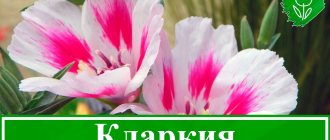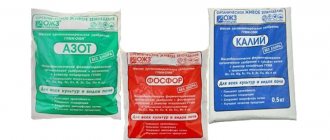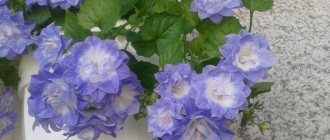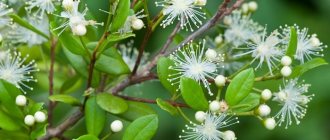In this article, talk about how to grow the middle bell in the garden. Features of the plant, types, most popular varieties, agricultural technology.
The middle bell is a beautiful flower that has simplicity and grace. He is unpretentious.
And it is precisely for this quality that gardeners love it so much.
This flower is so elegant and beautiful that breeders have developed many varieties with different shapes and a rich palette of shades.
Medium bell - detailed description
The middle bell, biennial or campanula is striking in its dissimilarity from other garden plants.
Flowers are popular among gardeners because they do not need to be replanted every year. They are not capricious or whimsical. They reproduce on their own.
Perfect for planting in flowerbeds among annuals, as well as as an independent single seedling on flat surfaces such as a lawn or garden plot.
Unlike annual species, biennials are planted one summer, and the next they delight with their gorgeous flowering.
The two-year-old species does not cause any problems or troubles.
It does not require special care.
Popular types of bells:
- Tall. This flower is ideal for growing both on flat surfaces and in flower beds. Tall crops make beautiful bouquets. It reaches a height of 100 cm.
- Medium height. This biennial flower is very popular. It reaches a height of 70 cm.
- Short. Ideal for growing on borders or alpine hills. Reaches a height of 30 cm.
The medium bell can be recognized by such parameters as: a straight stem with large cups in the shape of a “glass”, which can be of a wide variety of colors. For example, white, pale yellow, blue with a lilac tint.
Campanula can be:
The plant begins to bloom in early summer and continues until early autumn.
The most popular types of bells
Popular types of bells:
- Medium pale ocher or spadefoot
The plant pleases with its flowering from June to August. It can reach a height of 50 to 70 cm. The flower has a large number of pubescent stems. This species is characterized by large ocher-yellow cups. Does well in slightly alkaline soil. It loves light, so the place where it is grown should have good lighting. This variety is grown to decorate a stone garden or monument.
- Grossec
The variety can reach a height of 70 cm. It is characterized by hard-haired red-brown stems and a large cluster of buds, which can be blue-violet or lilac. This variety begins to bloom in late June or early July. Grows anywhere, but still prefers light. It does not require special care, as it can grow well both on alkaline and rocky soil. Ideal for decorating borders or rock gardens.
- Komarova
It reaches a height of 40 cm. It has curly stems, which are framed by stiff white hairs. The buds are large. They have a bright light purple hue. But this variety blooms a little - from mid-June to July. Grown to decorate borders or alpine slides.
- Spot
Reaches a height of 50 cm. The stem grows straight to the middle, and branches towards the top. The leaves are large, pubescent, and have an oblong, oval shape. The buds are also large and pubescent. They can be white or pale pink. Tolerates winter cold well, but is afraid of severe frosts.
- Takeshima
This variety reaches a height of 60 cm. It has thin, creeping stems, pubescent buds, which can be white, purple or pink. The plant delights with its flowering all summer long. The bell tolerates frost well and does not require specially treated soil or a lot of light.
These are not all types of plants.
Popular garden varieties
Campanula is best grown from seedlings. In this case, work with the plant must begin in early spring. After all, then the plant will get stronger and gain strength before wintering.
Sowing bells with seeds - what you need to know
To grow a beautiful flower in the garden or front garden, you will need to decide on the type and variety. Additionally, calculate some nuances for cultivation and care. The requirements are standard.
With properly planned actions, a flower will become an ornament, a decoration, and a means to eliminate a bad mood.
The best varieties for sowing
It is recommended to start planning by choosing a variety and type. In total, more than 300 types are known, but each of them can grow in certain climate conditions.
Most develop well if climatic conditions are characterized as moderate. Able to develop calmly:
- European countries;
- Central Asia;
- North America;
- Siberia;
- in the Caucasus.
The noble flower has taken root well throughout Russia (more than 150 species). Bells are divided according to the height of the stem, the order of leaves, and the shape of the petals. So there are three types:
- with a height of more than 1 meter - tall;
- if the flower is less than 1 m - low-growing;
- up to 20 cm - short.
There are also biennial, annual and perennial types of bellflower.
| Annuals | Two-year-olds | Perennial | |||
| Plants prefer southern regions for germination. Rarely take root in places with temperate or cool climates. | Forked. Description: height 15-20 cm. Abundant flowering. Pale purple flowers. | Two-year-old varieties can thrive in all types of soil. Difficulties may arise in the northern regions. Prefers warm regions. | Bearded hybrid species. Height: minimum 3 cm, maximum 30 cm. Color light blue. Shape: glass-shaped. | The varieties are distinguished by strong immunity. Develop well on mountain slopes and northern regions | Carpathian view. Reaches 30 cm. Colors: blue, white, purple. Hybrid form. |
| Kashmiri. Height: 5-8 cm. Flowers are small, purple. | Hoffman flower. It is distinguished by strong branching. Grows up to 45-50 cm. Color: white or cream flowers. | Gargan bells. Special flowers: round shape, three-toothed petals. Colored blue, pale lavender and white | |||
| Long-columnar bell. Strongly branched, abundant flowering. Height 45-50 cm | Thyrsoid (pale yellow) and spicate (bright purple) appearance. Inflorescence shape: funnel-shaped | Spiral-leaved. It grows to a maximum of 15 cm. The plant is creeping in white, blue or light blue. | |||
| Mirror of Venus. Grows up to 35 cm. Flower shape: saucer-shaped. The color is blue, lilac tint with a white center. | Large bell. Blooms late (late June-July). Height is more than a meter. There are about 7 flowers on the corolla | Chamisso. The variety is miniature (4-5 cm). The color is different from the majority of species: bluish-violet with white tints. |
In what month is it sown?
Before planting a bell, the gardener must take into account the region of growth and the time of warming. The recommended sowing time is the last month of spring.
An important point is the coordination of seed sowing according to the lunar calendar.
Since favorable days for work change annually, it is worth carrying out and planning procedures for caring for and growing a bell on the waxing moon (from the 3rd to the 14th lunar day).
Features of cultivation
Medium bell can be grown using seeds in open ground, or using seedlings.
But experienced gardeners still recommend seedlings, since when planting bells with seeds in open ground, flowering will occur only the next year. In addition, he is very picky about planting times. And if you plant flowers with seeds, there is no guarantee that they will germinate next year. But this is not scary, because flowering can occur in a couple of years.
Growing through seedlings will allow you to enjoy flowering this summer:
- You need to sow the seeds at the end of March.
- For the seeds to germinate, the soil temperature must be about 20°C.
- Before planting seeds, the soil in the boxes must be moistened.
- Next, the seeds need to be covered with a thin layer of purified sand.
- After this, the box with the future crop must be covered with polyethylene, thus creating greenhouse conditions. In this case, the flocks should be in the shade.
- After all, if there is light, the seeds will not hatch.
- Future seedlings must be sprayed with water daily.
- Shoots will appear in about 2.5 weeks. After the same number of days, the seedlings will finally get stronger. Caring for it should then be as usual.
- And already at the end of May, seedlings can be planted in open ground.
- At a distance of 30 cm from each other.
Sowing seeds in open ground
The plant is unpretentious: therefore, if the climate is not too harsh, you can plant directly with seeds in open ground. Usually, growing from seeds in open ground begins in mid-autumn or in May.
However, sowing in autumn is more preferable, since under a layer of winter snow the seeds are naturally stratified and hardened.
Planting is done in a garden bed in prepared soil. The composition of the soil should be as follows:
- turf land;
- river sand;
- old peat (not greasy).
There is no need to fertilize the garden bed with organic matter before planting.
The seeds are laid directly on top of the soil and are not buried. Since the seeds are miniature in size, deepening them can make it difficult for them to germinate. It is recommended, however, to sprinkle sand on top of the crops.
When planting in spring, the first shoots can be expected a couple of weeks after planting. Autumn planting even sprouts next spring - about 10-14 days after the snow melts and the ground thaws.
After three full leaves appear on the seedlings, the plants dive. It is necessary to leave the strongest and healthiest shoots in the garden.
Let's get acquainted with the features of caring for the Carpathian bell growing in the open air.
The soil in the garden bed is usually moistened only during the summer drought. When watering, use a bucket of water per 1 m2 of soil. After the moistening procedure, it is recommended to loosen the soil and remove weeds from it.
Important: in the spring you don’t have to water the bells at all, since the plant will get enough moisture from the melted snow. The bell is fed twice during the growing season.
In the spring, nitrogenous fertilizers are applied so that the green part of the plant forms faster. The second time, fertilizing is applied at the beginning of flowering. Compositions containing potassium and phosphorus are used, which will help produce more buds
The bluebell is fed twice during the growing season. In the spring, nitrogenous fertilizers are applied so that the green part of the plant forms faster. The second time, fertilizing is applied at the beginning of flowering. Compositions containing potassium and phosphorus are used, which will help produce more buds.
You cannot be too zealous with fertilizing, as otherwise there is likely to be excessive formation of green mass and poor flowering against this background.
This procedure is carried out the next year after planting. Faded inflorescences are cut off. The procedure allows:
- prevent spontaneous self-seeding;
- preserve the decorativeness of the flowerbed;
- provide the “living” part of the plant with sufficient nutrients.
Attention: when trimming leaves, do not forget to collect the fruit boxes first. Otherwise, self-seeding cannot be avoided
Every spring, in addition, it is necessary to inspect the plants and remove frozen, weak and diseased specimens.
And in order to make the flowering period longer, experienced gardeners proceed as follows: when the first wave comes to an end, they cut the flower stalks short. And after about a month, the Carpathian bell blooms actively and luxuriantly again.
Mulching
The procedure is carried out after watering and allows you to provide the plant’s roots with a sufficient amount of moisture. In addition, a layer of organic mulch also protects against weeds. Note that when growing bells on alpine hills or in other rocky landscapes, mulching is not performed.
When to sow bellflower seeds for seedlings, in what month
When is the best time to plant bellflower seedlings in 2022? Since seedlings grow relatively slowly, it is optimal to sow in March and early April . In the South, planting can be done in early March, in the middle zone (Moscow region) - in mid-March, in Siberia, the Urals, Leningrad region it is better to plant in early April.
You can select planting dates according to the 2019 Lunar calendar:
- Favorable days for annual crops:
- March - 12-17, 19, 20;
- April - 6-8, 11-13, 15-17, 29, 30.
- Favorable days for perennial bluebell:
- March - 12-17, 19, 20, 27-30;
- April - 6-8, 11-13, 15-17, 24-26, 29, 30.
- Unfavorable days for sowing:
- March - 6th, 7th, 21st;
- April - 5, 19.
Features of the variety: choosing a place for planting
The soil must have a neutral reaction (acidic soils are absolutely not suitable), well-drained (dampness leads to damping off of the bushes), light, and nutritious.
The description of the bell given by experienced gardeners suggests that this plant loves light and moisture. It tolerates temporary drops in temperature well.
Prefers well-fertilized and light soil. Does not tolerate acidic soils and stagnant moisture. In damp areas, the plant simply withers away. For one square meter of clay soil, fifteen kilograms of humus or compost must be added for digging. For loamy soils this amount increases to nineteen kilograms.
When the weather settles and the night frosts pass, the seedlings are planted in the ground on lawns and flower beds. This usually happens in mid or late May. Already in June you will see the first buds. There should be a distance of at least thirty centimeters between seedlings.
The bell is a fairly unpretentious plant, but you should know some planting features. The plant is considered a light-loving plant, but it tolerates partial shade well; very often it can be seen along western or eastern walls, where direct daytime sun does not reach. And such semi-shaded places can really be considered ideal.
The fact is that the lighting parameter is closely related to two other environmental characteristics: temperature and humidity. And here everything is clear - the bell loves moisture and feels great in the cool. Therefore, if you are looking for a plant to plant under a tree, near a shady gazebo, or a front garden on the east side, it makes sense to consider the middle bell.
In one place, the average bell grows from 3 to 5 years.
How to sow bellflower seedlings correctly: main steps
Planting bellflower seedlings at home requires compliance with certain preparatory measures. Let's look at them in more detail.
Seed preparation
Bluebell seeds germinate normally without preparation. In addition, after soaking they remain wet, making them very difficult to sow. If you still want to increase germination, you can treat them in a solution of a growth stimulant drug, and then filter through a thick cloth and allow to dry before sowing.
Important! If you want to grow a perennial bell, then you need to treat the seeds before sowing, namely stratify. To do this, wrap the seed in a damp cloth, put it in a bag and tie it. Leave in the refrigerator for 1 month or at least 2-3 weeks.
Soil preparation
In nature, in open ground, bells grow well on rocky, calcareous soils. However, when growing seedlings of this crop at home, light, loose, moderately nutritious, neutral or slightly alkaline soil is ideal.
Without any obstacles, you can plant the seeds in ordinary universal soil for flower seedlings . But before sowing, you should definitely add a loosening element to the soil , which will improve the structure and air and water permeability. For example, sand, vermiculite, perlite (as in the photo). You need to mix in the ratio of 3 parts earth and 1 part baking powder.
Selection of capacity
The most suitable option for planting bellflower seedlings is a wide and shallow container, the optimal height of which is 7 centimeters. It is not recommended to choose bowls that are too deep. But as for individual cups, cassettes, pots, sowing crops in them is not very convenient, because the seeds are very small.
The container must have drainage holes to remove excess moisture. If they are not there, then you need to do it yourself, for example, with a soldering iron, nail, scissors.
Before use, it is recommended to disinfect the containers, for example, spill them with a dark solution of potassium permanganate.
Master class on planting
As they say, it is easier to see once than to hear a hundred times. Therefore, we provide you with step-by-step photo instructions for sowing bellflower seeds for seedlings:
Carpathian bellflower - planting
The unpretentiousness of the Carpathian bell attracts many gardeners who want to decorate their plot or garden with beautiful flowers with abundant and long-lasting flowering. The plant can be grown both on the sunny side of the garden and in partial shade. When choosing a suitable planting site, you should remember that this perennial flower grows well in one place, without transplanting for more than 5 years. For a fragile plant, you should choose an area without drafts.
The best soil for growing a plant is a fertile, loose substrate with excellent drainage and a neutral or slightly alkaline reaction. Heavy and loamy soils, where moisture often stagnates or groundwater flows through, are not suitable for planting. The bell dies from excess moisture, which leads to rotting of the root system. Therefore, for planting flowers, you should choose flower beds located on hills or rocky areas. You can plant bells in open ground only after deep digging of the soil in the spring. If the soils are heavy, it is necessary to add river sand and humus; in poor soils, turf soil and complex fertilizers are added, as well as manure and peat, since these fertilizers can provoke the development of a fungal disease.
How to grow Carpathian bell from seeds
Spring planting of bell seeds in open ground is the most popular way of growing a flower for the southern regions, where in May the soil is already sufficiently warmed up. 2 weeks after planting, you can already observe the first shoots. After the first leaves appear on the sprouts, the bushes are picked and replanted at a distance of 10 cm from each other. You can sow seeds in the fall; the optimal month for sowing is mid-October. The first young shoots appear after the snow melts, when the soil warms up. The seeds of the Carpathian bell are very small; it is enough to spread them on the surface of loose soil and sprinkle them with sand. Under optimal conditions and compliance with all requirements for soil composition, 1 gram of seeds gives excellent germination.
Carpathian bellflower: growing seedlings
There is another planting method, but it is long and labor-intensive; this is planting seed for seedlings in boxes. You can sow seeds as early as February-March.
Stages of work:
For seedlings, prepare special boxes or containers with nutritious soil mixture. Ready-made soil intended for growing seedlings can be purchased in specialized stores or prepared independently. To do this, mix turf soil, humus and river sand, maintaining a ratio of 6:3:1. Seeds are sown in a moistened substrate. It is enough to scatter small seeds on the surface of the soil and lightly press them down without compacting them or covering them with a layer of soil. Containers with planted seeds are covered with film or glass and placed in a warm, well-lit room or windowsill. For 2 weeks, the film must be opened slightly every day to ventilate and moisten the soil using a spray bottle. It is also important to remove condensation that forms on the inside of the film or glass.
The first small shoots appear in the second or third week after they are sown in the ground. Seedlings grow slowly and require additional lighting. After the first leaves appear, the seedlings are picked and planted in cups of 2-3 bushes. In May, Carpathian bellflower seedlings are ready for planting in open ground.
Rules for caring for bellflower seedlings
You should care for bellflower seedlings (Carpathian, Californian, terry and any other) regularly, but the plants will not require too much of your attention. However, there are rules for caring for plants.
The temperature after planting and before emergence is 20-22 degrees Celsius. Afterwards the temperature drops to 18-20 degrees Celsius.
to water the seedlings before germination using a spray bottle so that the seeds sown on the surface do not dry out. And when the shoots appear, it is worth watering at the root so that water does not fall on the plant. It is necessary to always maintain a moderate level of moisture in the soil. Do not overfill under any circumstances.
Full lighting is very important for proper care of bellflower seedlings. Immediately after planting, you need to put the bowl in a bright place. And then, when the first loops appear, you should remove the plants to the sunniest windowsill. Ideally, daylight hours should be about 12-14 hours, so it is recommended to supplement the seedlings with phytolamps.
Note! Before emergence, the seeds should be kept in greenhouse conditions under a cover or film, but the covering material must be removed every morning and evening for 15 minutes to ventilate the crops.
Diseases and pests
Diseases and pests rarely affect bells. Mostly perennial species that grow in the same place for a long time are affected.
- Harmful bacteria accumulate in the soil over many years. They can lead to the death of the flower. To protect the plant, the soil is treated with a 0.2% solution of Fundazol.
- During prolonged rainy weather, a drooling captive may form on the bells. Get rid of it with garlic infusion.
- Of the pests, bellflowers can be affected by slugs. You can drive them out of the area with a decoction of hot pepper. Superphosphate scattered between the flowers also helps a lot.
If you follow all the rules for growing bellflower seedlings from sowing seeds to planting in open ground, then the plant will delight you with its bright flowering for many years.
How and when to plant bellflower seedlings
Seedlings should be plucked when 2 true leaves grow. For replanting, it is necessary to use individual containers with a volume of about 250 ml, but in the soil you can replant in the same soil that was used for sowing.
To properly plant bellflower seedlings, it is recommended to follow this scheme:
- Be sure to water the plants 1 or 2 hours before the procedure so that the plants can be easily removed.
- Fill new containers with soil and make small holes.
- Now you need to remove the plants from the container along with the roots. It is necessary to act very carefully, since this crop has a taproot system and long roots that can be easily damaged. It is best to divide the soil into small sections with the back of a spoon or fork and remove them from the bowl.
- Now you can easily divide the soil with plants into convenient sections. It is optimal to transplant 4-5 plants at once into a separate cup or cassette.
- Carefully bury the seedlings in the hole, lightly compact the soil around them and water.
Caring for bellflower seedlings after diving is almost the same. Only in the first few days it is recommended to shade the plants to protect them from unnecessary stress. After 2-3 weeks, you can fertilize with complex mineral or humus fertilizer for seedlings.
To grow good and strong bell seedlings, you must initially sow the seeds correctly and regularly perform proper and high-quality care at home. With careful and careful handling, the plants will delight you with their beautiful and graceful flowering.
Campanula medium belongs to the Campanulaceae family. A biennial plant, there are groups of varieties that bloom 15 weeks after sowing. In garden conditions, they are considered as biennial plants; in the first year they form a basal rosette of leaves. The leaves are significantly different from the leaves that grow on the flower shoot the following year. The leaves forming a rosette die off in winter because they emerge quite late and are easy to pull out like a weed. It is worth marking the place where the bell grows. In late spring, leafy stems appear, ending in a long inflorescence. Several stems grow from one rosette. The stems are quite rigid and do not require support. The leaves are sessile (without petioles), narrow and lanceolate. The inflorescence is a raceme or panicle, depending on the group of varieties. Individual flowers are quite large, up to 8 cm long. Consisting of five fused petals, the ends are free and slightly turned outward.
Rules for caring for and growing in the garden
A cup and saucer will grow even with minimal supervision, but abundant, long-term flowering is only possible if certain conditions are created. The bell needs watering, loosening the soil, and fertilizing.
The Chinese set does not like constant abundant soil moisture. The beds sown with seeds are sprayed with a spray bottle. Regular watering during the formation of buds is considered mandatory. In dry, hot weather, flower beds should be irrigated as the soil dries out. Small and sparse flowers are a sign of lack of moisture. It is better to store water for irrigation in containers or collect rainwater.
The rest of the time, the bells can withstand slight drought quite steadfastly, and often die from waterlogging. At the end of the summer season, during the rainy season, the plants stop being watered, otherwise the root system may rot.
In well-prepared soil, seedlings appear friendly, strong and do not require additional feeding. Bells are fertilized in the second year of life. The first time is in early spring, when the protective layer of branches or foliage is removed from the rosettes. The solution is made as follows: 30-40 g of ammonium nitrate per 10 liters of water, water the beds and flower beds.
During the formation of buds, the bells are fed a second time, using an infusion of weeds and ash. The following mineral fertilizers are used:
- Kemira (500 g per 1 sq. m.);
- Agricola (50 ml per 10 liters of water);
- Pokon (100 ml per 10 liters of water).
After watering, the soil in the root space of the bells must be loosened. At the same time, weeds are removed.
Rotted manure and compost are often used as mulch, but peat is undesirable because it acidifies the soil. Organic matter also plays the role of fertilizer on poor soils.
Bells do not need to be pinched. During flowering, flowers that have wilted are pinched and removed so that the plant does not waste energy on ripening the seeds. In the autumn of the first year, mandatory pruning of leaves is carried out.
If the plant becomes drooping and yellowish, the stems and leaves lose their elasticity with proper care, a good solution would be to transplant to another location or drain the soil. Replanting is carried out in case of soil depletion or changes in relief conditions.
The bell is dug up along with a lump of earth, preserving the root system from damage as much as possible. The planting hole should be larger than the root ball, and for better rooting it is necessary to regularly spray the leaves during the adaptation period.
Bluebell Cup and Saucer needs shelter for the winter only in areas with harsh winters. You should not insulate a plant planted in the southern region. With the onset of spring, the roots may dry out and die from excess heat. In areas with a temperate climate, bells are insulated in the fall with sawdust and branches. A layer of snow on top will help you survive the winter without consequences.
Description
It grows on rocky, rocky slopes in southern Europe, especially southwestern France and southern Italy. Due to its large flowers, it is grown almost all over the world. Americans are especially fond of bells. Height , 60-90 cm. Flowering period , June-July. You can prolong flowering by regularly removing spent flowers to prevent the plant from setting seeds. Flower color , pink, lavender, violet blue, white, many varieties of different shades of blue. Place , in completely sunny places it blooms more massively; in partial shade the flowering is not spectacular, but lasts longer. Frost resistance , bellflower in the colder part of our country is not fully frost-resistant, it is better to cover the growing area with compost and mix it with soil in the spring.
A little about bells: brief information
The genus of bells (Campanula) includes 300 species. These are cosmopolitan plants that are found in different latitudes and climatic zones. They delight with little blue islands in the mountains, forests and meadows. Bells are characterized by:
- herbaceous form;
- alternately arranged, simple leaves;
- different heights: from low to large forms;
- coloring of the corolla in various blue shades;
- inflorescence in the form of a panicle or brush;
- sometimes - a single arrangement of flowers;
- fruit in the form of a capsule filled with small seeds.
Marina Ivanova
He is an expert in his field and an experienced flower growing practitioner.
Ask a Question
Note: The name of the bell is telling: it really looks like a bell. The variety of natural species and created varieties allows each gardener to find his own variety of garden bell, which is traditionally grown from seed.
Varieties
- Mixture of colors - height 80 cm. Large, double, goblet-bell-shaped flowers of various colors, 6-8 cm in diameter. Blooms June-September. Biennial.
- Terry mixture of colors - height 80 cm. Double flowers with a diameter of 6-8 cm, collected in large pyramidal inflorescences. Cut flowers remain fresh for up to 2 weeks.
- Cup and saucer is a popular variety of the medium bluebell. Height 80 cm. The calyx of the flower is of an original shape, reminiscent of a cup standing on a saucer. Mix of colors.
- Carmine rose - height 80 cm. The flowers are carmine pink, 6-8 cm in diameter, collected in large inflorescences. Blooms June-September.
- Snezhana - height 80 cm. Blooms with snow-white flowers with diameters of 6-8 cm.
- Raspberry ringing - height 75 cm. Double flowers, a mixture of colors.
- Campana white - height 75-85 cm, grown in a greenhouse or open ground. The flowers are snow-white.
- Rosea - height 80 cm, with pink flowers.
- Cerulea is a variety with rich purple flowers. Height 80 cm
- Cheerful gramophones - a mixture of colors, distinguished by an erect, stiff-haired stem.
- Dreaming is a variety with an erect, stiff-haired stem, 80 cm high. The leaves are oblong-oval, the stems are ovate-lanceolate. The flowers are large, pink, 4-5 cm in diameter, collected in pyramidal inflorescences, 30-50 cm long. Blooms June-July.
- Alba is a variety with white pyramidal inflorescences that resemble an ice cream cone.
- Cantenberry bells is a variety with pyramidal inflorescences. Biennial 80 cm high. Mix of colors
- Crimson rose is a biennial with pink inflorescences. Flowering period June-July. Height 70-80.
- Rhapsody is a mixture with double inflorescences of various colors, white, pink, lilac and purple.
The middle bell is not particularly picky about the ground. Prefers permeable soil that is fairly fertile and retains moisture well. There will be more inflorescences and larger flowers. On weak soils, to obtain lush flowering, in the spring add a large dose of compost and a multi-component dose of fertilizer.
In the best soils, especially those planted in partial shade, the plants will be taller; in the event of heavy rain or strong winds, it is worth protecting from bending.
When buying seeds, you should pay attention to the height of the plants; low varieties can be successfully planted in pots (standing on the ground) as the central element of the composition, or the entire pot can be planted with a bell. But they are completely unsuitable for any type of balcony boxes, they are too high.
If the summer is rainier, double varieties will suffer more than regular varieties.
Reproduction methods
The easiest and most common option for breeding bells is growing from seeds. This method involves planting in the first season and flowering in the second. Seeds germinate only in the dark; this feature must be taken into account.
Seeds are sown in open ground in late April-early May, when the soil temperature is not lower than 4°C. Bells are often grown using the winter method - the seeds are scattered on the garden bed in the second half of October, in the fall. To obtain early seedlings, sowing is carried out in boxes with soil in March.
Preparation
Soil preparation is an important step for successfully obtaining strong seedlings. The best soil would be a mixture of 6 parts turf, 3 parts rotted compost and 1 part clean river sand.
For seedlings, plastic containers or wooden boxes are selected, which must be checked for holes to drain excess moisture. Flowerbeds and beds on the site are made high and with a mandatory layer of drainage at the bottom if water stagnates in this place.
Planting process
The prepared soil is watered, then sowing begins. Step by step description:
- The soil is lightly compacted, creating a flat surface.
- The seeds are scattered evenly over the surface.
- Lightly sprinkle the top with fine clean sand, without embedding it into the soil.
- Cover the top with glass, film, or special material. The temperature for sprouts to appear is about 20°C.
- It is important that germination occurs in the dark, so the glass is darkened and the film is chosen dark.
- The beds and boxes must be ventilated every day.
- 2-3 weeks after the seedlings appear, they are picked. The distance between plants is left at least 10 cm.
- Bells are planted in a permanent place a month after the first picking, the distance of one plant to another is 25-40 cm.
Cuttings
The cuttings are planted under the film, after cutting off the lower leaves from them. The soil should be moist, and at least two internodes should be left above the ground surface. Young shoots of the second year are used for cuttings, the lower cut is powdered with Kornevin and carefully immersed in the ground. Rooting occurs within 2-4 weeks.
These flowers can be propagated using cuttings. In the second year after planting, in the spring, when the stem has formed, the healthiest shoot is selected and a cutting is made. It must have at least three internodes. The leaves are removed from it so that they do not take away the strength of the plant.
The cuttings are planted in well-moistened soil. Two internodes should remain on the surface. Cover the cutting with a cut plastic bottle or glass jar.
We hope that now an elegant “cup and saucer” bell will definitely appear on your site. Growing this plant from seeds, as you can see, is not too difficult. By following all the rules of planting and care, you will be able to admire the luxurious blooms all summer long.
Growing from seeds
Medium bell seeds are small, 1 gram = 5000 pieces. For uniform sowing, it is recommended to mix the seeds with dry, clean sand. Medium bellflower is grown from seeds (without filling the seeds with soil) in early June on a sowing site. Approximately 60% of seedlings germinate after 14 days. Planting in permanent place in September.
In a not too warm, bright room, you can try to grow varieties from the “Champion” group, growing them as annuals. Sowing takes place in early March. Until the seedlings have sprouted, the seedlings are left in a warm room. After picking, when the plants have two leaves, they are transferred to the most illuminated, cold room; low temperatures stimulate the formation of flower shoots and prevent the plants from stretching. Planting in open ground after frost.
The best conditions for the growth of bellflower
First of all, you need to choose a sunny area for planting, since the bell feels better in an open, well-lit place. The soil should be well-drained with a neutral or slightly alkaline pH. This flower does not like acidic and slightly acidic soils. Therefore, it is periodically recommended to alkalize the soil by mixing it with wood ash. Moderate watering is necessary - this flower does not tolerate stagnation of water. Subject to these conditions, the maximum number of buds is ensured.
The ideal climate is warm and cool, but the flower does not tolerate heat and frost well. During the cold winter months, seeds in the soil can withstand up to -30°C...-35°C.
Depending on the variety, the height of the stems ranges from 50 to 100 cm and above, and the number of buds ranges from 45 to 50 pieces. The bud size can reach 7 cm, and the most active flowering time is usually June-August.
Application
Medium bell is an excellent plant for the back border of a flower bed. Lower varieties are suitable for the central part of the flower bed. In sunny places they look good with lower grasses with arched leaves, for example, foxtail pinnately. It can be planted in front of flower beds; the pinnately bristlecone will cover the yellowed leaves at the base.
Later varieties can be cut into a vase and remain fresh for up to 8 days. Cut when two flowers are fully developed. Terry varieties are more durable and look better in compositions with delphinium inflorescences.











